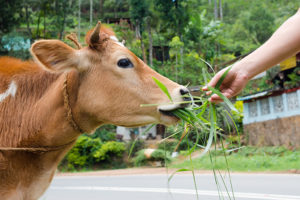Lechtins: The Foods You Are Eating That Are Making You Fat, Inflamed, and Tired
By Dr. Anne Zauderer
We live in an incredible time in history. At no other point has life been so comfortable for humans. We don’t have to forage for our food, we live in temperature-controlled environments, we sleep on soft mattresses, and we have vehicles to transport us to where we need to go. Yet, we are in the midst of an epidemic of chronic diseases.
2.1 billion people are overweight or obese. That is one-third of the world’s population1. Inflammation-related conditions are on the rise2:
- Almost 10 percent of young children are affected by allergic dermatitis (eczema).
- More than 25 million Americans have asthma.
- Over 24 million Americans, 8 percent of the population, have diabetes. Estimates are that by 2025, the number of Americans with the disease will be close to 50 million.
- Arthritis and joint disease affect 43 million people in the United States, almost 20 percent of the population. This number is expected to surpass 60 million by 2020.
- More than 5 million Americans have Alzheimer’s disease.
- Depressive disorders occur in approximately 18.8 million American adults, or about 9.5% of the US population age 18 and older.
 People are stressed, tired, anxious, depressed, disconnected, in pain and angry. We are quick to want to medicate our symptoms away without asking what could be the root of all of those symptoms. I can’t speak to your exact condition, but what my experience has taught me is that inflammation is at the root of most chronic diseases.
People are stressed, tired, anxious, depressed, disconnected, in pain and angry. We are quick to want to medicate our symptoms away without asking what could be the root of all of those symptoms. I can’t speak to your exact condition, but what my experience has taught me is that inflammation is at the root of most chronic diseases.
There are common causes of inflammation in our diet (that we all know we should avoid) such as sugar, white flour, chemical additives and preservatives, high fructose corn syrup, trans fats, and many more. However, what if I told you that there was a protein embedded in many of the healthy foods that you are eating that could be triggering your inflammation? The proteins I’m talking about are called lectins.
Lectins, not to be confused with lecithin (an emulsifying agent) or leptin (a hormone that regulates fat storage and appetite), are proteins that are found in high quantities in grains, beans, and certain fruits and vegetables. These proteins are made by plants as a defense mechanism against predators. Lectins create an inflammatory response in the predator that eats them. Most animals, apart from humans, when they eat something that doesn’t make them feel good, they try to avoid it!
How do lectins work? They are large proteins that are very sticky and bind to carbohydrates (sugars), especially polysaccharides, in the animal’s body after it consumes the plant. These sugar molecules are primarily on the surface of cells and disrupt messaging between cells by creating a toxic or inflammatory response. One example of a sugar molecule that lectins bind to is sialic acid, which is found in the gut, the brain, between nerve endings, in joints, in bodily fluids, and in the lining of blood vessels. This is why people who consume a lot of foods that are high in lectins are inflamed and can have achy joints, brain fog, and fatigue.
In his book, The Plant Paradox, Dr. Steven Gundry says that, “Lectins facilitate the attachment and binding of viruses and bacteria to their intended targets…. Some people – those who are more sensitive to lectins – are therefore more subject to viruses and bacterial infections than others.” This makes me curious about people who have chronic infections, such as Lyme disease, which causes fatigue, achy joints, and brain fog – all the same symptoms as a sensitivity to lectins.
Another effect that lectins have is that they can stimulate weight gain. One specific type of lectin, wheat germ agglutinin (WGA), is especially responsible for this. One of the ways it does this is it bears a striking resemblance to the hormone insulin. Insulin is what makes sugar available to our cells so that they can burn it for energy. Because WGA mimics insulin, it binds to the insulin receptor sites on cells, which blocks the action of insulin. This results in poor energy utilization (fatigue) and more sugar being pumped into fat cells, stimulating weight gain and insulin resistance, which is the precursor to diabetes.
Lectins can also stimulate leaky gut. Because the lining of our digestive tract is only one cell layer thick, when lectins attack the mucosal lining of the gut, they create inflammation and pry apart the tight junctions in the intestinal wall.
What foods in the American diet are high in lectins? Below you will find a list of foods to avoid. For a more comprehensive list, I would recommend Dr. Gundry’s book, The Plant Paradox. The reason for the title of his book is that, paradoxically, there are a lot of healthy foods that contain vitamins, minerals, and antioxidants that are essential for our health but are also high in lectins. We need to be aware of how we prepare foods, the quantity we consume of certain foods, and way food makes us feel.
Food High in Lectins:
- Wheat
- Corn
- Rice
- White potatoes
- Oats
- Quinoa
- Legumes (including peanuts and cashews)
- Soy
- Seeds (pumpkin, sunflower, chia)
- Cucumbers
- Zucchini
- Pumpkins
- Squashes (of any kind)
- Tomatoes
- Eggplant
- Peppers
- Goji berries
Another very important point to consider is that you are what you eat, but you are also what your food ate. This means that if you are consuming animal protein from an animal that was fed a corn and soy-based diet, you will be getting lectins in the milk, fat, and protein from that animal. In addition, if you consider the fact that farmers feed animals grains to fatten them up, you can start to see the inflammatory effect of lectins at work in those animals. Because cows are forced to eat an unnatural diet of corn and soybeans, this causes heartburn in the cows. The heartburn is such an issue that farmers have to put calcium carbonate in their feed to prevent it, otherwise they stop eating. Half of the world’s calcium carbonate is fed to livestock for this very reason.
If you want low-lectin meat, you need to consume animal proteins that are pasture-raised, pasture-finished. You need eggs that are completely pasture-raised. Certain labels on foods are meant to lure you into a sense of security, when all they are is a marketing ploy. A few labels to be aware of are:
- “Cage-free or Free-range” – this only means that a door was left open for a minimum of 5 minutes per day. Most chickens are in such crowded conditions, that they never see the light of day.
- “Vegetarian-fed” – Animals were fed an (unnatural) diet of grains, most likely GMO. This is commonly found in poultry. Chickens are insectivores, not grain eaters.
- “All natural” – this term is basically meaningless and has not been defined by the FDA or USDA.
- “Heart healthy” – this was a label devised by the food industry to make you feel better about choosing highly processed foods. Froot Loops have been labeled as “heart healthy” by the FDA.
Before I close this article, there is one thing that I would like to highlight. Each of us is at a different place in our health journey. I applaud anyone who makes better food choices! It can seem overwhelming for most people to think about eating a low lectin diet. I hope this information will empower you to really look at your food choices and make connections between what you are eating and how you feel. If you are already eating a healthy diet and yet still feel fatigued, have joint pain, can’t lose weight, or have any of the chronic inflammatory conditions listed above, I would encourage you to explore removing lectins from your diet. If removing all lectins is too overwhelming, I would encourage you to start with removing processed grains and sugar from your diet. Once you experience an improved sense of well-being, hopefully that will be encouragement to dive in a bit deeper.
The food you eat can be either the safest and most powerful form of medicine
or the slowest form of poison. – Ann Wigmore
- http://www.healthdata.org
- http://www.genesmart.com
- Gundry S. The Plant Paradox: The Hidden Dangers in “Healthy” Foods that Cause Disease and Weight Gain. New York, NY: Harper Collins (2017).





